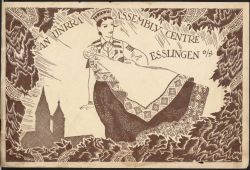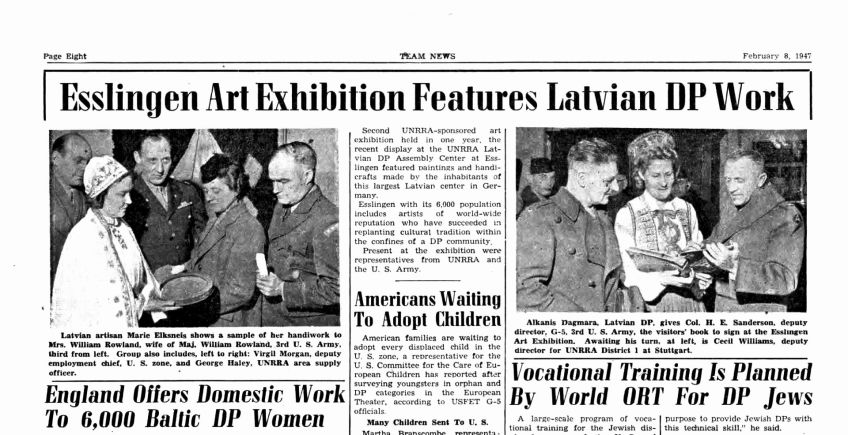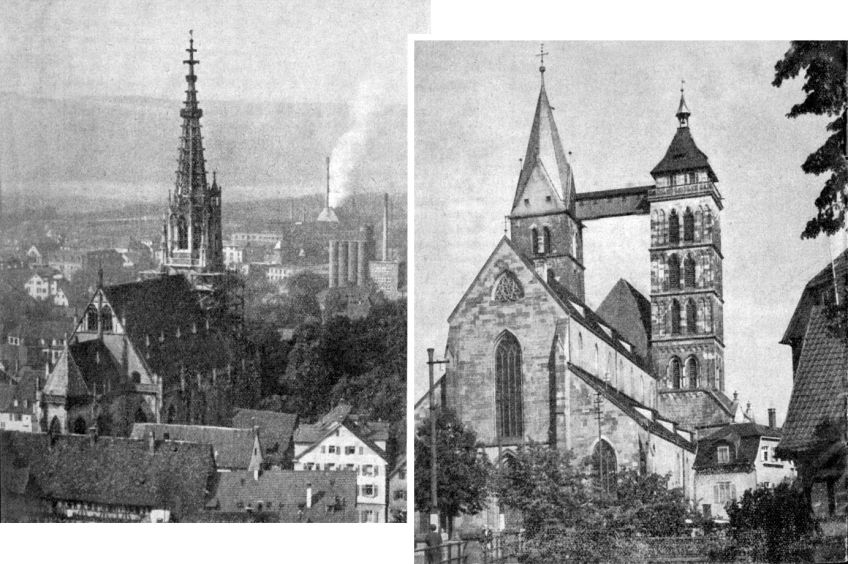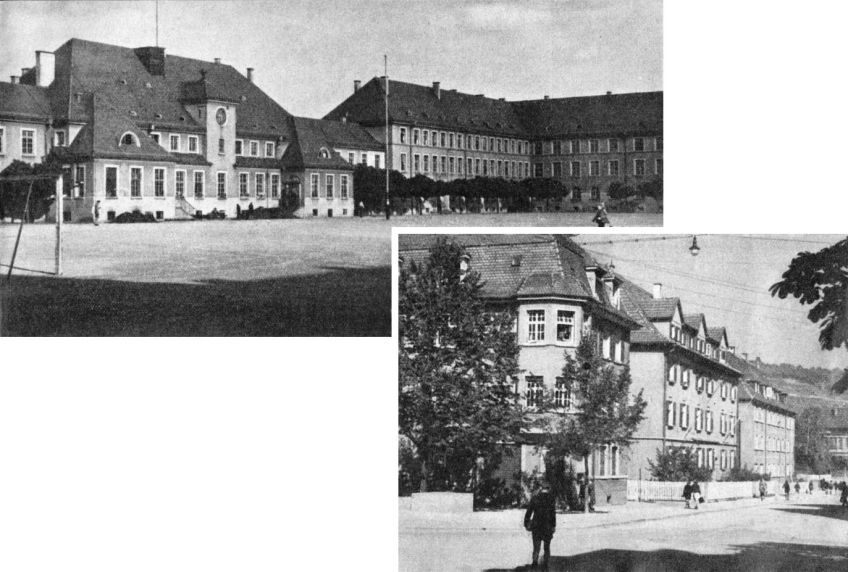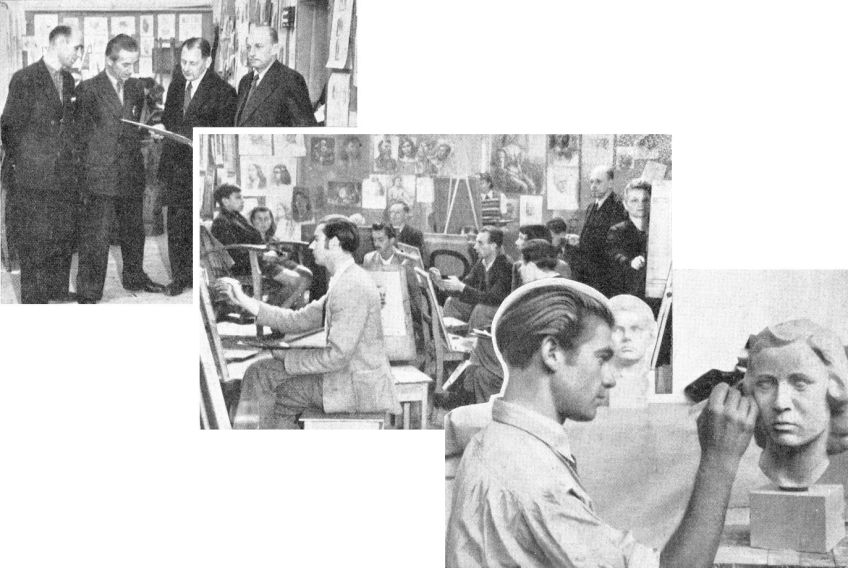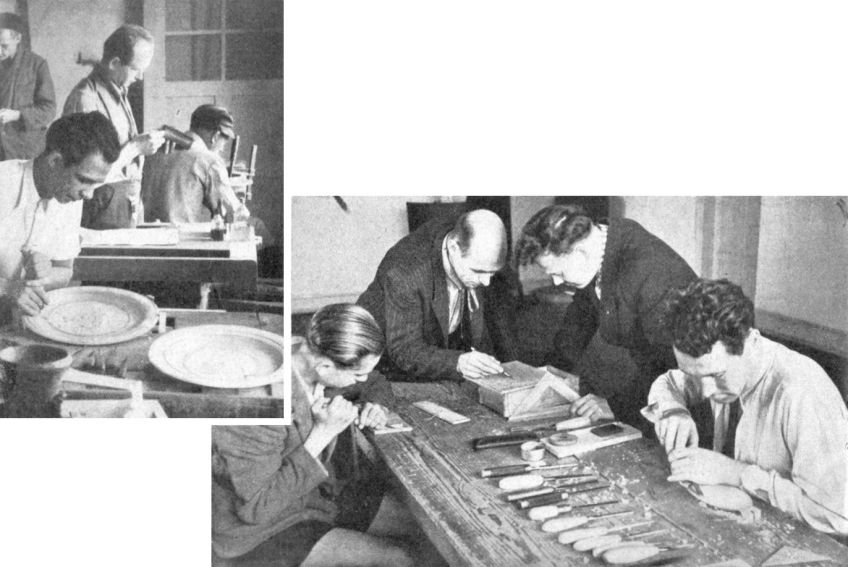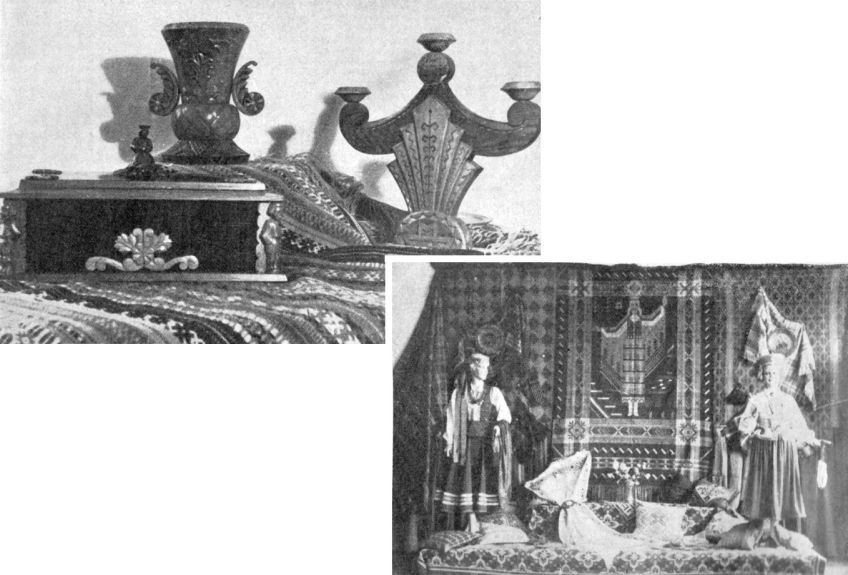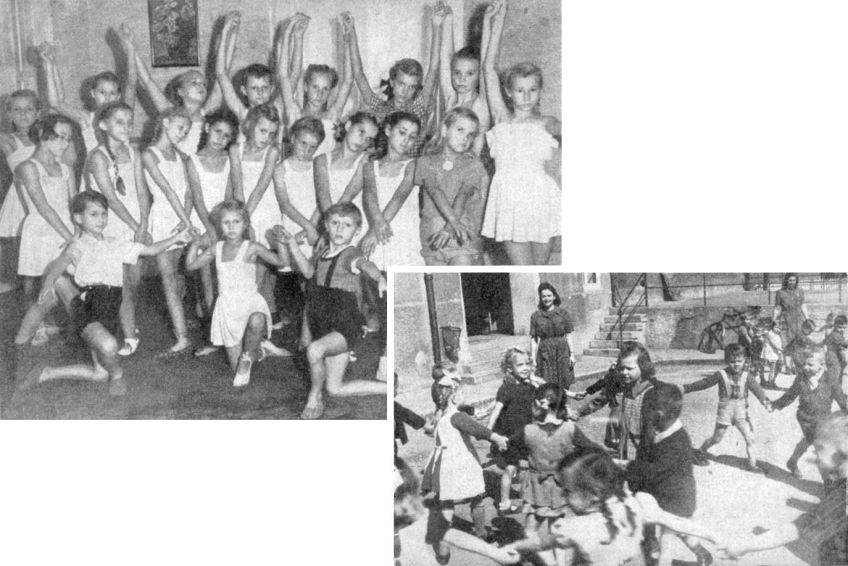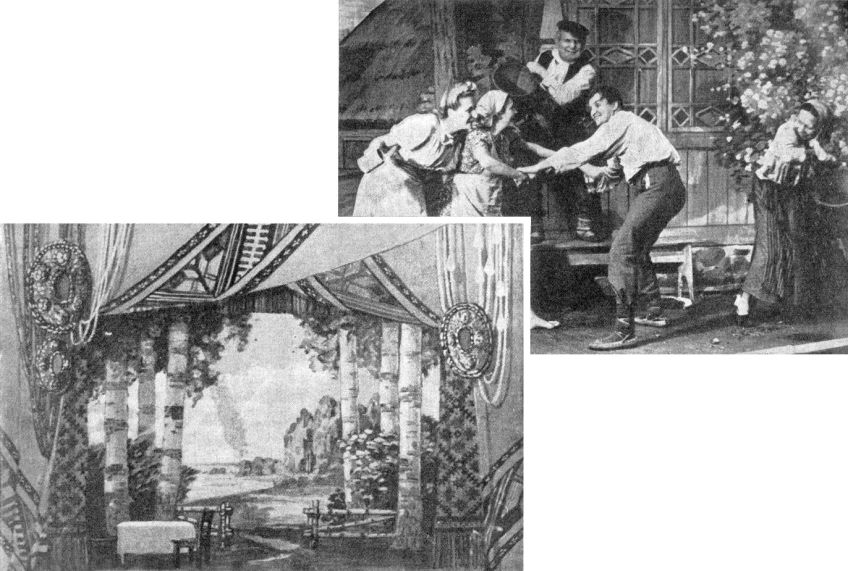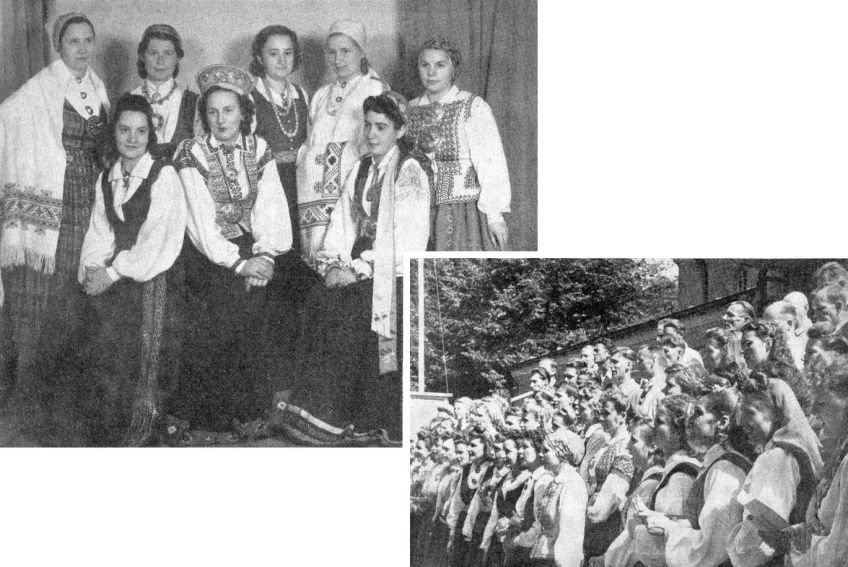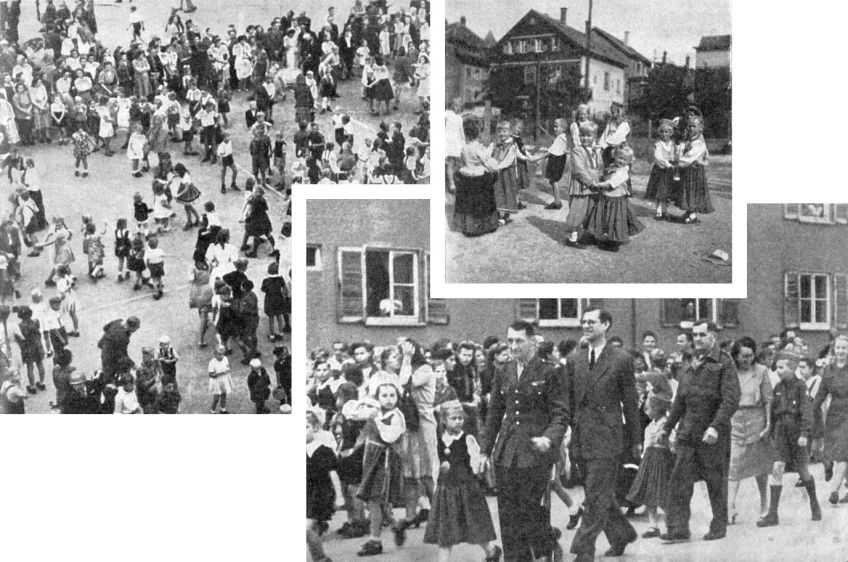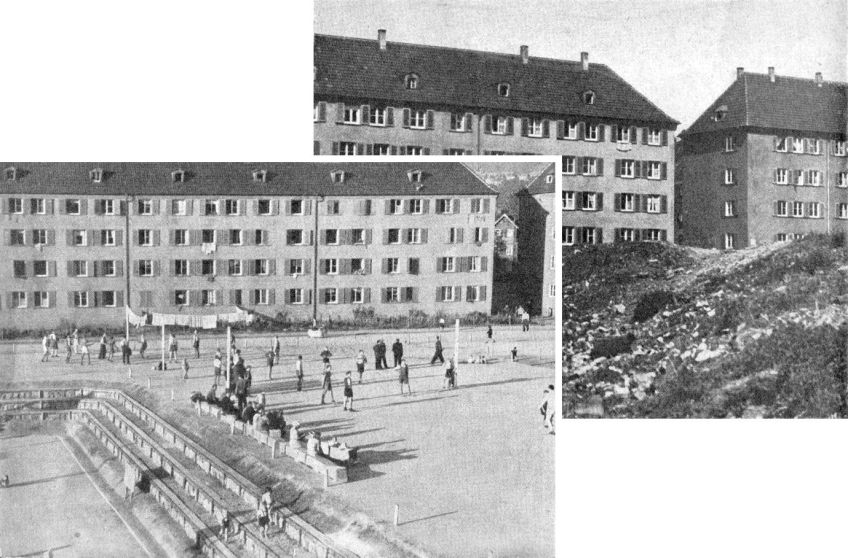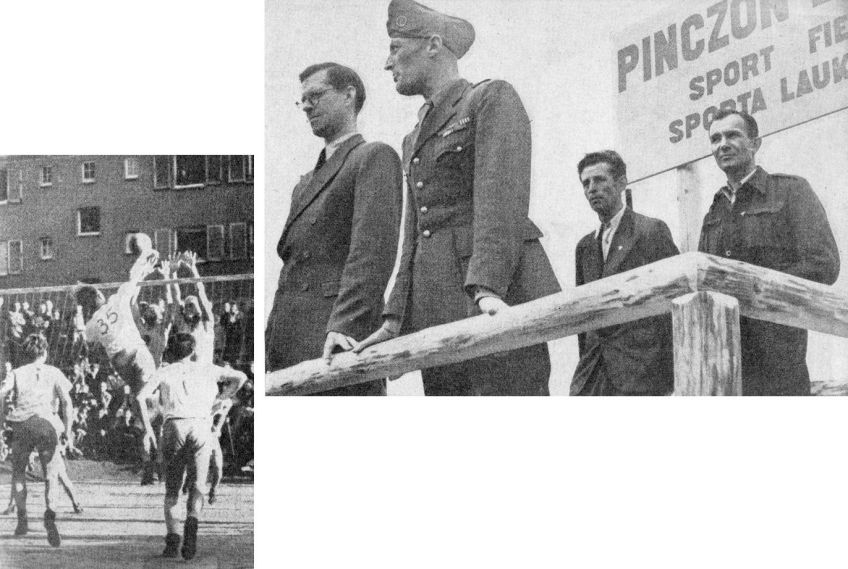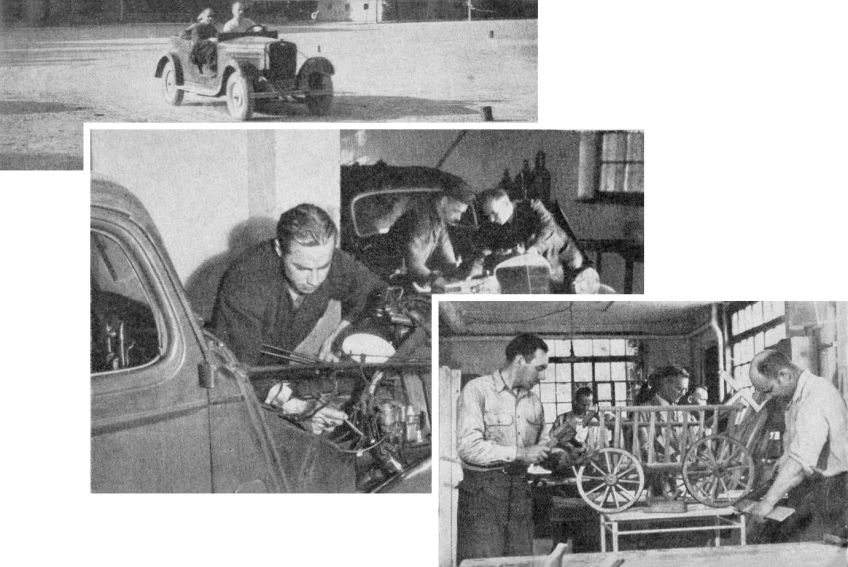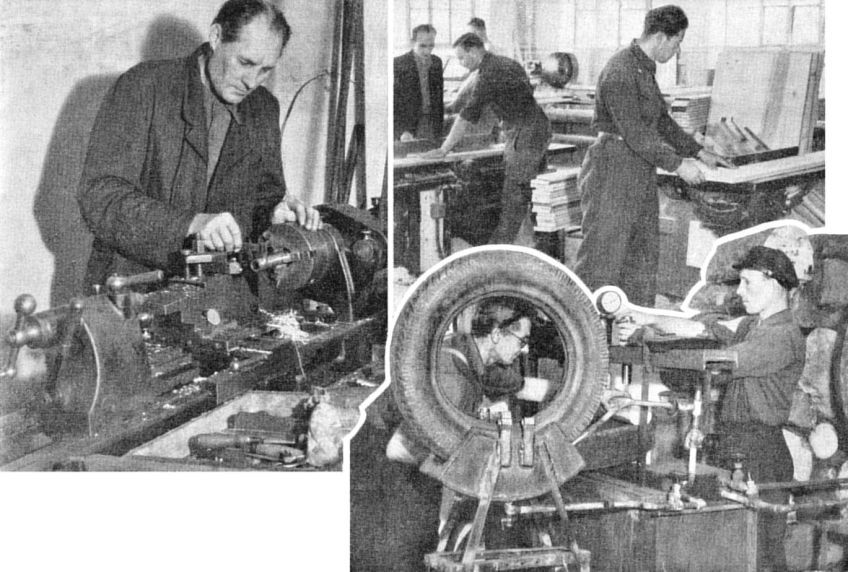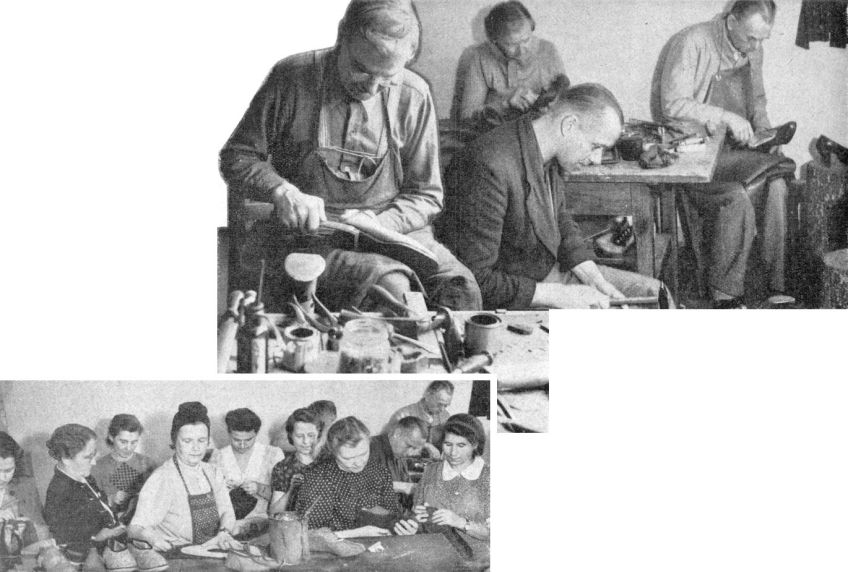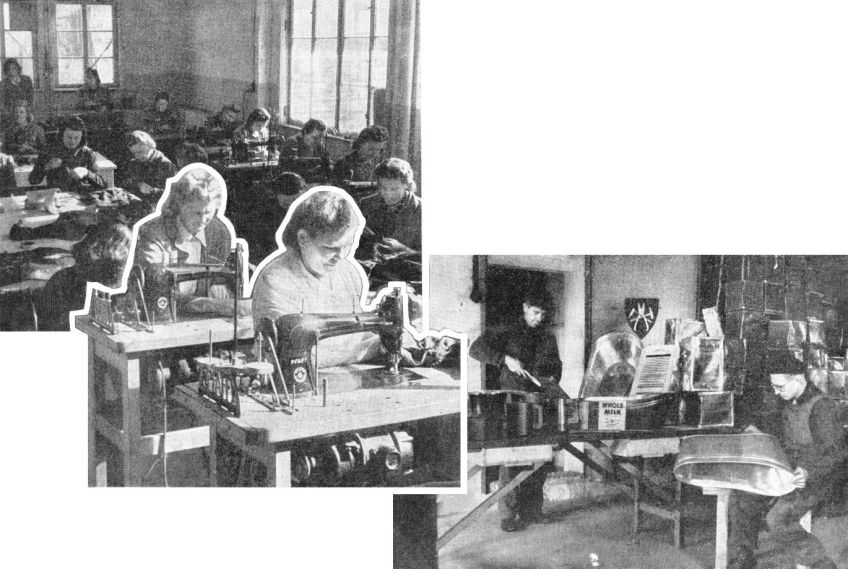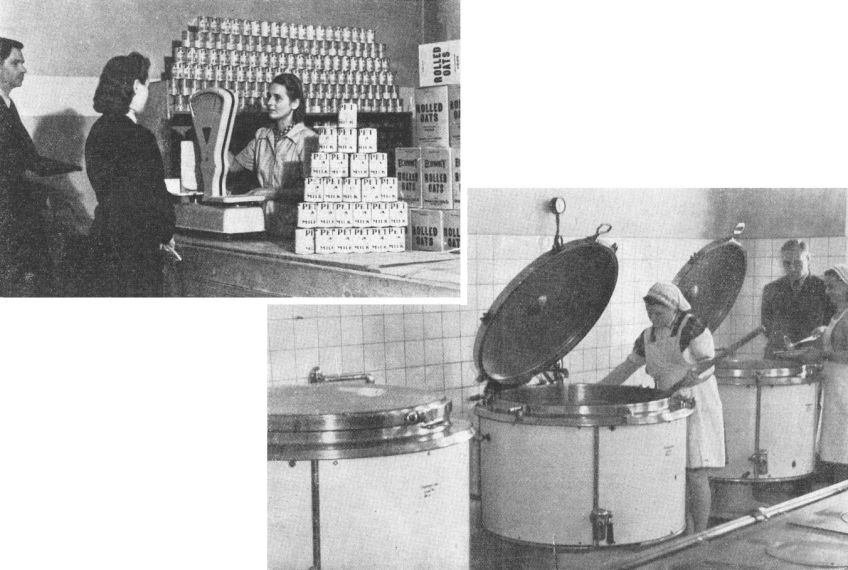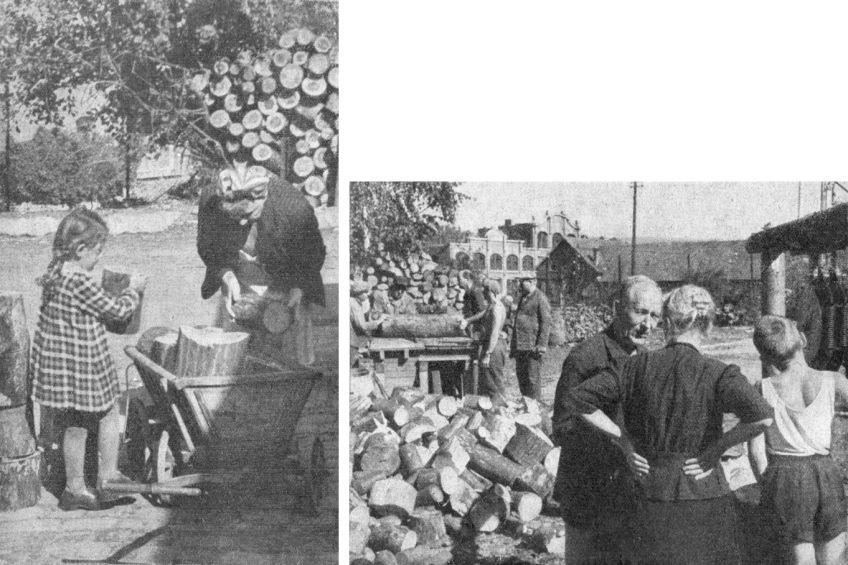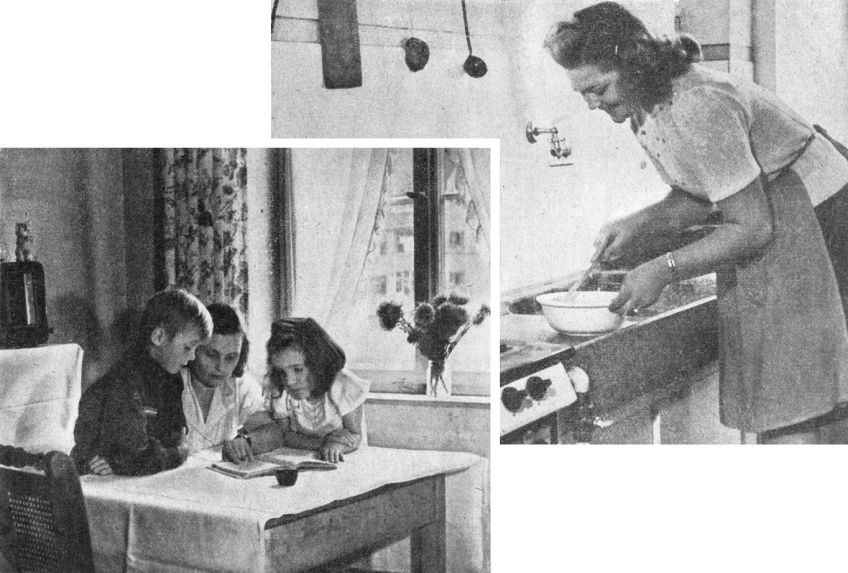Latvian refugee life at Esslingen
The Displaced Persons (DP) camp at Esslingen am Neckar, that is Esslingen on the Neckar river, was the largest Latvian-population DP camp. An April 13, 1946 UNRRA report of assembly centers in the American Zone put the camp population as of March 30th at: 1 Lithuanian, 4 Estonians, 5,606 Latvians, 2 Jews, 80 others, with "Total A.C." of 5,691, and "Total Team" of 5,894. (Esslingen was administered within 1st DISTRICT - STUTTGART, 9th Infantry Division Area.) This was more than double the Latvian population of any other DP camp at the time.
One might mistakenly romanticize the hubbub of activity at Esslingen — even commemorated in a Latvian musical set against the backdrop of DP camp life. Below, Soviet apparatchiks attempt to entice Latvians to return to their "dzimtene", land of their birth — all they have to do is sign the sheet and all will be forgiven, everything confiscated returned. As is commented after the song, Latvians did not take the Soviets up on their offer, and the West was quick to realize that the Soviet Union was not a friend. Latvian refusal to return did not prevent Soviet propaganda from subsequently dispelling the "lie" of Soviet oppression with "success stories" of Latvians who did return to the USSR.
The reality was there was no going home. Latvians were "citizens" of the USSR. Thus, refugees were "defectors" and "traitors." Many, such as Peters' parents, had been slated for future deportation to the Gulag. It's not paranoia if your fear is grounded in reality.
Not only had they lost their homeland, but refugee Latvians feared their compatriots left behind would be Russified and assimilated. Preserving and passing on language, traditions, arts, crafts, literature... was a moral imperative to ensure the survival of Latvian culture. It was also an overt act of defiance against the Soviet regime. Lastly, DP'ers were acutely aware of the need to prove themselves industrious and reliable, to demonstrate their worth to the West so they could be welcomed as constructive contributors, not burdens, to society.
In its 30 pages of text and photographs, An UNRRA Assembly Centre — ESSLINGEN o/NECKAR offers a glimpse into Latvian DP life in the aftermath of WWII.
Read more
- See DP era references in our Exile Experience section.
Introduction by René Pinczon du Sel, Director
Could the following text and pictures show you that UNRRA did not fail in this way.
In Germany with UNRRA since the 19th April 1945 I was appointed on the 10th August to take over UNRRA Team 208 which was already in Esslingen since the 20th June. The operation had not a very great number of Displaced Persons (about 10.600) but was rather difficult because spread over three Kreis1 with 17 camps of about 23 different nationalities.
In every Kreis in Germany such mixed nationality camps were the rule, but in September the Military Government and UNRRA planned the consolidation of camps by nationality and large movements of displaced persons took place in October to obtain this end.
After having given away two Kreis to other UNRRA Teams, Team 208 remained with the one Kreis of Esslingen. A big number of Displaced Persons were shipped to different camps and Esslingen was supposed to have only a large Latvian camp of about 4000 inhabitants. About 1200 were already on the spot and the remaining were scheduled to arrive in Esslingen on the 17th October.
I prefer not to speak of this day which was awful for everybody: for the people who arrived in cold weather to find cramped quarters without heating, without furniture and for UNRRA who got these quarters from the Germans the same day and who were unable to procure the so much needed furniture. Cooking was done in a big kitchen 5 miles away and the food brought down to town three times a day.
Anyhow, with the understanding of the displaced persons, their help, and also with the energetic extensive work of all my UNRRA colleagues we managed to overcome these difficulties and by the end of October the Esslingen Assembly Centre had nearly the same set up as at the present time:
a small group of Poles attending the Technical School in Esslingen,
a small group of Stateless,
a large Latvian centre.
The purpose of this booklet is to show the different aspects of this Assembly Centre, its common and private life, its activities, and as you will easily understand, the largest part will be given to the Latvians. But in this introduction I would like to say some words of our Polish and Stateless groups.
Because of their small number, of their generally good accommodations in private billets, the stateless already living in Esslingen were authorized to remain there. They have their own leader and their own elected committee who are working under UNNRA supervision. Many of them are working with UNNRA, the Army or in German factories. Their small number does not allow for a large extension of the welfare program, but they have the possibility to take part in the Latvian activities.
There is in Esslingen a very well equipped and well known German State Technical School for training engineers. In August 1945 with the Military Government's authorization a small group of Poles were allowed to use its laboratories and some class rooms. When the Poles had to move to other Kreis in October last, I was allowed to retain here the students who were accommodated in a former factory which was then partitioned off into rooms for four to six students.
Step by step we got more space in the school and more students in the "Hotel" until we reached the present number of 300 students. All courses are given in the Polish language by Polish teachers who were called for from the whole American Zone.
Now 100 Latvian students also attend this Technical School with their own teachers and a few months ago the Germans again started their courses. A committee of teachers of these three nationalities was then formed for establishing the policy and the schedule of attendance to the laboratories. It works smoothly and with the full understanding and cooperation of the three parties.
The Polish Camp has a committee of teachers which is in charge of all school problems with the cooperation and agreement of the Polish Repatriation Officer. This committee deals with the management of the school, elaboration of the program, etc. There is an administration leader who is responsible for the administration: cooking, cleanliness, maintenance and discipline inside the camp and a committee of students working together with the two above.
These students having got the opportunity to restart their studies in this school would like to finish them as soon as possible so as to be able to bring to their Homeland together with the strength of their hands, a real knowledge which is also necessary in order to rebuild their country.
I believe it is time for me to let the Latvians explain for themselves what is now their camp after one year of effort. Before coming to Esslingen I did not know them at all, I scarcely knew the geographic situation of Latvia. After one year of constant and deep collaboration with many of them, I really appreciate their good conduct and behaviour, their fine organizational mind, their love of study and knowledge, which exists even among the old people, their desire to work and their ability in handicrafts. Actually they need only the provision of raw materials to be able to produce, goods in big quantities.
I feel sure that after having seen, in this booklet the results obtained in one year, and especially if a trip to Esslingen allows you to visit the Centre and its workshops, you will have the same good opinion that I have of the Latvians.
At the end of this long introduction allow me to thank all the UNRRA members who helped me to make this camp like it is and to confess that after four months as Director of a French spearhead Team, I was more afraid, when arriving in Esslingen, to find and lead a Team of 15 members of 9 different nationalities than to manage the camps under my charge. I believe that in Esslingen, like in most UNRRA Teams we got the proof that many nations can work together and be quite friendly if they have the same goal and try to understand each other.
My sincere thanks and affectionate friendship to all the ones who helped me so much in my task: Army, Military Government, UNRRA, national leaders without forgetting the translators, editor, photographer, artists and the editorial "GO DEVIL" staff (60th Infantry — U.S.A.) who produced this booklet.
René Pinczon du Sel, Director UNRRA Assembly Centre Esslingen
THE LIFE OF THE LATVIANS IN ESSLINGEN
by Feliks Krusa
Growth of the Centre
The world after World War II resembles a turbulent sea just after a gigantic storm. It takes a long time for the sea level to smooth out all the wrinkles on her troubled brow. Similarly, the world cannot find as yet a solution of how to attain lasting peace and prosperity. Many thousands and millions of people have lost their home countries and are seeking for a place of refuge and the possibilities of building up a new existence in foreign countries. The American Zone of Occupation, and Land Württemberg in particular, is overflowing with such refugees. If for a foreigner it is difficult to remember all the names of the numerous "ingen", "tingen" and "lingen" scattered all over Württemberg just like fallen leaves are scattered on the ground in a wood, every Latvian is sure to remember the name of one small town. This name is Esslingen. The Latvians will always speak of it as that of the biggest centre where they assembled after undeserved persecution and the tempests of the war, where they herded together just like a flock of birds or wild animals terrified by fire. In this town they have already spent many days and months, and they have been observing the characteristic movements of its life. Esslingen has indeed definite characteristics and peculiarities. In winter it endeavours to cover itself innumerable times with a sheet of snow, but without ever succeeding: the white sheet dissolves just like the froth in a glass of champagne. In Summer Esslingen is like a young girl lying deep in a haystack. But strictly speaking, Esslingen cannot be compared with a young girl. He who has scrutinized her features more closely will find that she is very old. Her name is mentioned already in an old chronicle dating back as far as the year 865. For many years the town has been the bone of contention of the Württemberg nobility and at times this town has been more famous than its big neighbour Stuttgart. In Esslingen has been located the Mint of the State. Paracelsus, the famous reformer of the science of medicine has lived here, and King Rudolph, the founder of the Dynasty of the Habsburgs has honoured this little town with a visit and has strolled along its narrow streets and lanes. An anecdote concerning King Rudolph clearly shows how narrow indeed the streets of Esslingen have been. When the King, who had a big crooked nose rode into Esslingen, someone from the crowd shouted out: "What a mighty long nose!" The King turned his head aside and said: "Now you can pass, my lad." In later times the streets of Esslingen have become much broader and you can pass easily and without disturbance.
When before the war a speedy express train dashed past Esslingen and carried along many a Latvian towards Switzerland or still further south, not one of them was ever struck by the idea of getting out and of settling down in this little town. The Latvians arrived here only during the war, when they were deported to Germany for forced labour. Similarly, many a unit of labourers was landed in Plochingen and Reichenbach. Here they were forced to work under very hard conditions in sawmills and other factories. The labourers received their food from the common kitchens of the factories. The food was frugal and insipid, but the working hours were very long. The labourers had to sleep on the ground in unheated barracks. The children in particular suffered very much from cold. In consequence of this they were ailing and in poor health. Also the women had to do hard work. They were often called out in the nights to dig air-raid shelters or to clear away snow from the roads. To wash oneself was a luxury, because it was very difficult to get water. The smallest infringement of regulations was severely punished.
When the Allied Forces were victorious over the Germans, the French Army entered Esslingen and extended immediate help to Displaced Persons. The Latvians, together with Estonians and a few Lithuanians could now avail themselves of the opportunity to live collectively in wooden barracks by the city blocks of houses. Later the building of the Burgschule (Palace School) was placed at the disposal of the Baltics. When the American forces entered Esslingen and the action of concentrating smaller communities into bigger ones was begun, to Esslingen were transferred the Latvians from Gingen, Oehringen, Goeppingen, Heidenheim, Ulm, Bad-Mergentheim, Heilbronn and Stuttgart. Thus in Esslingen on the Neckar, which river has been much sung of by the minstrels, there grew the largest Latvian Assembly Centre in the whole American Zone of Occupation.
Professions and occupations represented by members of the Centre
Although the number of members of the Latvian Settlement in Esslingen constantly varies, on the average it fluctuates between 5700 to 5800 persons. There are more than 1200 children below the age of 15. Among the adults there are 600 more women than there are men. Away from their native country all the members of the centre live in comparatively similar conditions and are wearing almost similarly worn out clothes. Thus the outward appearance of these persons does not reveal much difference, although they represent various professions and occupations. Among the members of this Centre there may be found representatives of science and the most diverse "white collar" professions, as well as farmers, artisans and labourers.
In the Settlement there are registered 264 farmers and 200 clerks. Here live clergymen of 23 different confessions,
|
37 doctors-surgeons, |
150 teachers, |
|
33 dentists, |
8 scientists, |
|
37 nurses, |
17 writers and journalists, |
|
27 musicians, |
24 artists-painters, |
|
14 architects, |
41 actors, |
|
24 engineers, |
48 lawyers, |
and all other professions are also represented in this Centre. With regard to education, the Esslingen Latvians stand on a rather high level. Out of every 10 inhabitants one has university education and more than 1200 are high school graduates. Although in Latvia among the people there were practically no illiterates to be found and an illiterate person had to be searched for like a needle in a haystack, this "curio" is to be found in Esslingen, for in the registers of the Centre one can find noted two illiterates.
The members of this Centre are good linguists. Besides their mother tongue, many have mastered the English, French, Russian and German languages. Among the Latvians here one can find persons who know either Polish, Lithuanian, Estonian, Swedish, Norwegian, Czech, Danish, Italian, Croatian or Portuguese, or even Turkish, Tartar or Greek. The majority of the inhabitants are Lutheran Protestants, the minority are of the Catholic (476), Orthodox (243), Baptist (59) and Mohamedan (4) faith.
“The White House”
The "White House" of Esslingen is marked with a signboard "UNRRA Team 208."
From this building come all the important orders, bulletins, notifications and regulations concerning food rations, welfare activities, preservation of health, organization of work details, etc., as well as letters of praise, thanks, reprimands and punishments. People come and go here like busy bees carrying smaller or bigger parcels of requests and statements of their needs. Mr. R. Pinczon du Sel, director of UNRRA Team 208, calmly and patiently considers all the requests. Having thought each problem over, where to draw the line between what is allowed and prohibited,the possible and impossible, the plans to be fostered or subdued, he makes one just decision after another. His hard-working assistants diligently concentrate their efforts on figuring out how to carry-out the various suggestions and projects.
Ever since Director R. Pinczon du Sel arrived in Esslingen and started supervising the administration of Team 208, he also gave to the Latvians themselves the possibility of developing their initiative to find ways and means to overcome the various difficulties of daily life. He agreed to the idea that an administrative body from among the Latvians should be formed in this Assembly Centre.
Administration of the Centre
Each day of a Latvian refugee is tinged with different needs and worries. If every person individually tried to settle the problems that confront him or her, the result would be more chaotic than it would be positive. Then we should be like people who get lost even amidst three pine-trees, not to mention the whole forest. In order to create an organic and normal flow in the life of the Centre, UNRRA gave permission for the Latvians themselves to create their own inner administrative offices: the Latvian Council and the Board of the Committee. The Council which consists of 50 elected representatives discuss all problems of major interest, which emerge in the life of the Centre and require thorough consideration. As soon as there is a necessity to confer upon some questions Mr. A. Kacens, President of the Council, calls upon the representatives, in order to discuss the burning problems and to find the best possible solution. Mr. Kacens has given much subject matter to the witty newspaper-men who say that the former Latvian Consul General of Ankara would be able to settle even the difficult problem of the Dardanelles. This Council is something similar to a "Parliament" of the Esslingen Latvians, which elects the Board, as well as the Chairman and his deputy for the Centre.
A kind lady who made the author of this pamphlet familiar with the activities of the Board and, by the bye, besides the necessary information, as a "special ration", awarded me a bright smile, was at the same time writing the 104th Protocol of the Board's meetings. Reading the Agenda of the Board alone makes one wonder at the variety of questions discussed in the meetings.
The Latvians in Esslingen have been lucky in one respect. They have not elected persons who would lead them along erroneous labyrinths. Their representatives have proved to be men capable of efficient work. Still more lucky they have been in finding the right chairman for the Settlement. This man has been more than a year now always on the alert to give the right course to the life of the Centre, just like a captain on the bridge who directs his ship through all the dangers and tempests of time. As soon as difficulties emerge anywhere, one always hears somebody call out: "But where is our Chairman, Mr. K. Kalniņš?"2 This call hardly ceases when Mr. Kalniņš is already to be seen knocking on the various doors of the authorities. All trust him and all know that the Chairman possesses much inner strength, that he knows the "traffic" signs and knows how to find the correct way of solving the most difficult and diverse problems.
The various administrative sections are being supervised by members of the Board. There are the Administrative, Educational and Cultural, Economic, Supply, Welfare and Labour Sections.
Field of education and culture
The Latvians of Esslingen can be proud of two imposing buildings in which most of the educational activities are taking place. One of these buildings houses the Latvian Elementary school, the other, the Latvian High school. Everyone who is acquainted with educational work in other settlements can testify that this work is being done on the right lines in Esslingen. In this respect we may rightly develop a feeling of pride. The time will come when, the 585 pupils of the Elementary School — who during the breaks between the lessons now chirp like sparrows — and the 224 pupils who attend the High School, will realise that in Esslingen no pains have been spared to widen the horizon of their knowledge. Those, who have observed the teachers in that difficult time when there were no text books, when the teachers searched and inquired for material everywhere, will know how much they devote themselves to their work. Nobody is happier than the teachers themselves when they can say: "Our pupils study industriously." The pupils do their work really well and conscientiously. The same conscientiousness is to be observed also in their little sisters and brothers, the toddlers, who attend the kindergartens. These institutions are managed by trained educators. The children pass the time here in pleasant and instructive games, and in the evenings when they come home, they can tell volumes to their parents of how pleasant it was in the kindergarten.
Among the schools which prepare the young people for practical life are to be mentioned the School of Technology which is a technical high school and the Trade school. For adults has been established The University Extension with the same aim. English Courses and courses for driving exist also at other Latvian camps but the number and variety of the courses here is so manifold that if they were represented by a diagram, this diagram would look like a huge tree with many branches. "I am an agricultural engineer, but I do not know how to make cheese", says a gray-haired father of many children and puts down his name for a course in dairy work. "Who knows whether I shall be able to earn my living by teaching philology" are the words expressing the doubts of a woman professor who decided to take up a course in tailoring. The University extension provides practical courses in various branches of craftsmanship and invites all Latvians to learn a trade. The slogan is: "Let us learn some practical profession."
The Latvians living in Esslingen are studying also in other towns. 123 persons attend the Higher Technical School Stuttgart, the Universities of Heidelberg, Gottingen, Tubingen, UNRRA University in Munich, the Higher Technical School in Karlsruhe, the Academy of Agriculture in Hohenheim and other similar institutions.
Seldom does one see so many entertainment posters as in the quarters of Esslingen where Latvians live. A poster has scarcely time to turn yellow before it is replaced by a new one. This proves how alive our cultural life is here.
A great number of other camps will surely envy the one in Esslingen for the variety of public entertainments, which have nearly spoiled the inhabitants. Esslingen has the good fortune to have quite a number of famous Latvian theatre artists living here. The artists have been very active offering to the deported Latvians the possibility of enjoying many performances of a high standard. The theatre prepares one show after another. Professor J. Kuga, former President of the Academy of Arts, paints all the scenery. As there is no other material available, he paints on flour or sugar sacks sewn together.
Here are often given excellent concerts. All the prominent Latvian singers, headed by Mr. A. Kaktiņš let the public hear the best Latvian songs and Latvian music. Our neighbours, the Estonians, have also been given the opportunity of appearing on the stage in Esslingen.
The choir of the Centre in its masterful performances reflects the deep feelings of the national sentiments. Latvian painters, illustrators, engravers and sculptors, as well as masters in applied arts have shown their skill in a number of exhibitions which were appreciated and highly praised by many foreign experts. We have noticed with real satisfaction in an American paper lines about the opening of a Latvian art exhibition:
"The Latvian colony in Esslingen, which numbers some 6.000 persons, includes several artists of world wide reputation — men whose work is hung in galleries and museums throughout the globe. These artists, who left all material possessions behind them, brought their culture with them, and are fighting successfully, as anyone who views their exhibit here can well determine."
The Latvian artists who live in Esslingen represent various sections of the artistic field. They take all possible pains in offering their countrymen not only entertainment, but also training for those who intend to study art. Just as Don Juan could tell from a foot-print the looks of a young beauty, Professor Kuga, Professor Liberts and Mr. Vidbergs, a master of etching, as well as all other tutors at the Art Studio are able to determine which abilities can be most successfully developed in a student. These men can also determine what the leading imaginative power of a prospective artist is, by merely looking at a few strokes of his pencil. They take the utmost pains in order to foster these young talents. Mr. Mercs, sculptor and specialist in wood carving, tries to improve the natural gifts of his pupils.
Since 5th May 1946 at another end of the Centre one can hear the piano exercises from pianissimo amounting to allegretto furioso of 200 students of music. The Ballet School has its quarters nearby and tries, in spite of its modest size, with its 120 pupils, to renew the excellent reputation of the Latvian ballet.
Latvian writers and poets have come from many different places to stay in Esslingen in order to live in closer contact with their people and present them with the newest works reflecting their impressions and depicting their experiences of the period after they were expelled from their homes. Recently some very essential Latvian books were published in Esslingen. These were eagerly awaited by the public. Here the Latvians in exile also publish a newspaper "Latviešu Ziņas" ("Latvian News") and the periodical "Laiks" (The Time), the largest Latvian magazine printed abroad.
Esslingen has also become a meeting place for the scientists and fellows of the Latvian University, who recently commemorated the opening of the Riga University 27 years ago. In general Esslingen has become an important cultural centre for the Latvians. After the Right Reverend Archbishop Dr. theol. T. Grīnbergs3 transferred his residence to this place, Esslingen has become the centre also of religious life for the protestant people of Latvia.
All these cultural developments have been hampered by all sorts of difficulties and obstacles which were, however, overcome by common effort. The local UNRRA officials have given every support possible to all the cultural projects of the Latvian centre.
Work is a blessing
Every Latvian who has built up his life either by using his head or his hands, who, when he was still at home tried o make his country a beautiful and pleasant place to live in, is aware that it is a misfortune to be out of work. This belief has not been changed by exile, as work is essential n order to live, just as medicine is necessary for the sick.
Nearly one half of the Latvian population in Esslingen are small children, pupils, old or sick people who are unable to work. The other half is working either for the Army in he Military Government or in various enterprises and offices of UNRRA.
Approximatively one fifth of the Centre inhabitants have no permanent occupation. These participate in enterprises for the common benefit of the Community. As examples can be mentioned the cutting and delivering of firewood and cleaning the garbage dumps around the houses of the Centre. These garbage dumps have been transformed into a pleasing Sport Field which gives the youth the possibility of outdoor entertainment.
The Latvian Settlement in Esslingen can be proud of its imposing number of workshops and enterprises. The workshops have been established, not only to satisfy the various needs of the inhabitants, but also to offer a possibility of learning such handicrafts as may provide the best opportunities of earning one's living in countries abroad. The variety of workshops is really noteworthy. There are workshops for woodworking, tailoring, shoemaking, where masters and apprentices are as busy as bees from early morning till late at night.
If a year ago one Latvian asked another: "What is the time?" the most likely answer was: "I don't know, my watch has stopped."; Now times have changed and at the watchmaker's one can see on the shelves a number of watches and on the walls are hanging clocks each one testifying with its own tune that all of them are back to life again to serve their purpose, viz. to measure time. During a month ten men have succeeded in repairing about a 100 watches. This is a remarkable fact, considering that as no spare parts were available these had to be made by hand.
Not everybody can buy without difficulty a wash-basin, a pan, a tea pot, a grater or any other small household utensil. But, the Latvian tinsmiths conjure up miracles. They manufacture these utensils out of old tin cans.
At another place future gold and silversmiths are sawing, filing, soldering and welding much more precious materials. Engravers adorn and specialists in embossing work give the final touch to specimens of this fine art.
There is a place where you can also have your radio set repaired and where electrical kitchen utensils are manufactured.
Somewhere else people can learn how leather must be treated. A special workshop is established in the former "Fliegerschule" (Aviation School) where a number of women manufacture hats and house shoes from old clothes supplied by UNRRA.
Tailors for ladies and gentlemen are transforming and mending old clothes, but if new material is provided, they can make new clothes as well.
Vulcanizing of tires in the Centre workshop is done for UNRRA cars, as well as for the cars of other organisations.
Promotion of welfare
It must not be thought a hive of activity exists only in the workshops. The medical men, doctors and dentists extend the blessings of their knowledge to the sick in the hospital. UNRRA Police in blue helmets look after order and neatness in the houses and in the streets. In the food distribution centre fat, marmalade and peanut butter are being weighed as precisely as at the pharmacist's. Peanut butter in particular is a food stuff formerly quite unknown in Latvia.
Dispensaries have done good work by inoculating the whole population of the Centre against small pox and by making injections against typhus and typhoid fever.
Some work for the common good is done in turn by every inhabitant. This is checked on a card index which is precisely controlled in order to remind forgetful persons of their obligations. The distribution of clothes by the Welfare Section is a subject of close supervision which demands the attention of a number of women clerks.
Sports are sponsored by YMCA and by YWCA and the activities of the scouts and girl-guides are attended by 500 young people.
Such is daily life in the Latvian Centre in Esslingen.
In a short synopsis it is impossible to survey all the various activities carried on by the Latvians in Esslingen. This would require a new chapter to be added to guide book "Baedeker".
Assisted by UNRRA members, the Latvians consider it their duty to preserve the noblest and the most valuable qualities of the Latvian nation, in order not to loose spirit despite the depressing circumstances prevailing in exile.
We are familiar with the smiles of the sceptics and the doubts of those people who lack the enterprising spirit. Such people are to be encountered in Esslingen. However, any impartial observer would say that on the whole the Latvian Centre is busy. By evading difficulties, by becoming apathetic and sleepy, no work may be fostered. On the contrary, a firm belief that without work there is no sense in life is the shortest and best way to progress and success.
Photographs — home and school
The remainder of the booklet consists of illustrations. Our commentary as here appears in italic.
Page headings from here forward are ours.
Today, the Bacelaer barracks have been transformed into residences surrounding Palmscher Park.
Photographs — arts and crafts
In at least one DP camp, Peters' father worked as an art instructor for schoolchildren. One of Peters' choir members recalled having him as a teacher.
Photographs — activities
Photographs — at work
As Peters' mother told the story, whenever they prepared relocate, his father had a habit of giving away their housewares to those that desperately needed them, rather than to pack them up and bring them along to a new DP camp — where, as soon as they settled in, he would then have to make a whole new set for themselves.
Photographs — sustenance
One should not take away the belief that all DP'ers were well fed. At a different DP camp, Peters' parents were told to eat grasses when food rations ran short.
 Credits (pasted in).
Credits (pasted in).| 1 | Administrative district of a Land in Germany, similar to a county. |
| 2 | Kārlis Kalniņš (March 31, 1902–January 5, 1967), career diplomat, Esslingen DP camp Latvian elder. |
| 3 | Teodors Grīnbergs (April 2, 1870–June 14, 1962) was a Latvian prelate of the Evangelical Lutheran Church of Latvia, its second Bishop, and its first Archbishop from 1932. He continued to serve as Archbishop of the Evangelical Lutheran Church of Latvia in exile until his death, having remained in Esslingen. |
 Gallery
Gallery